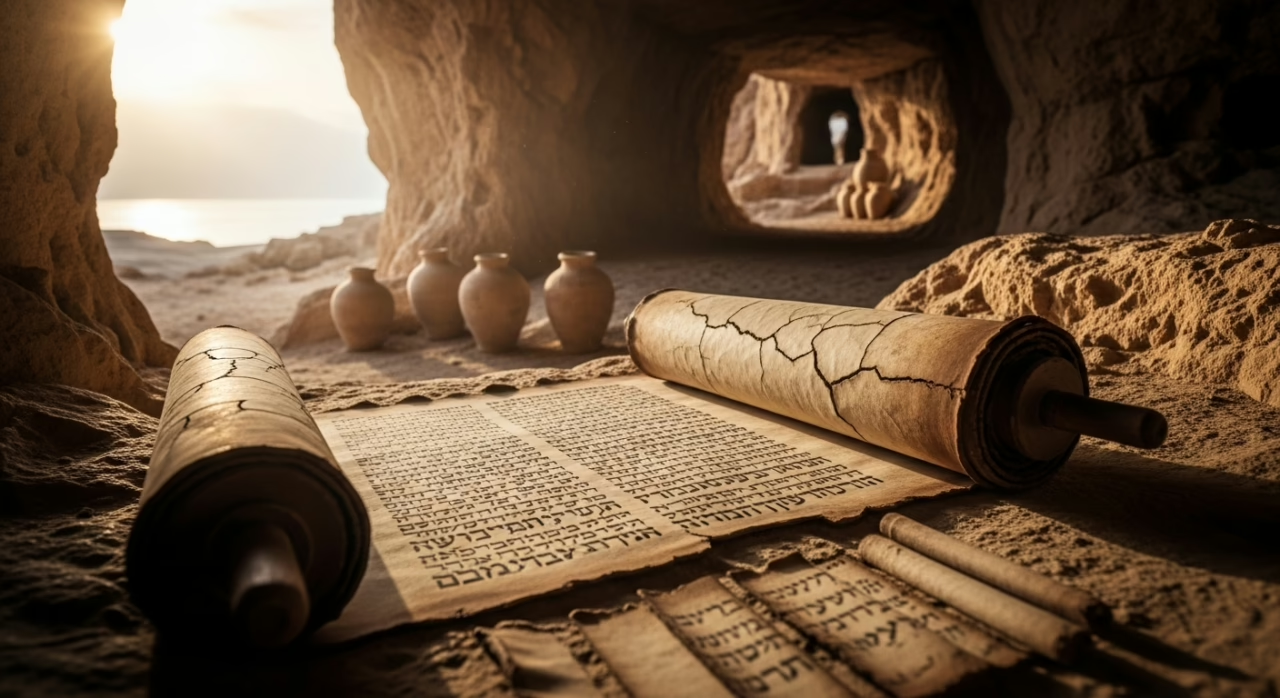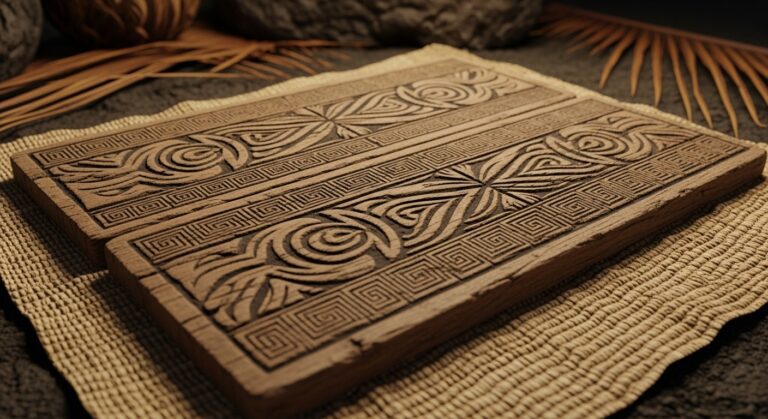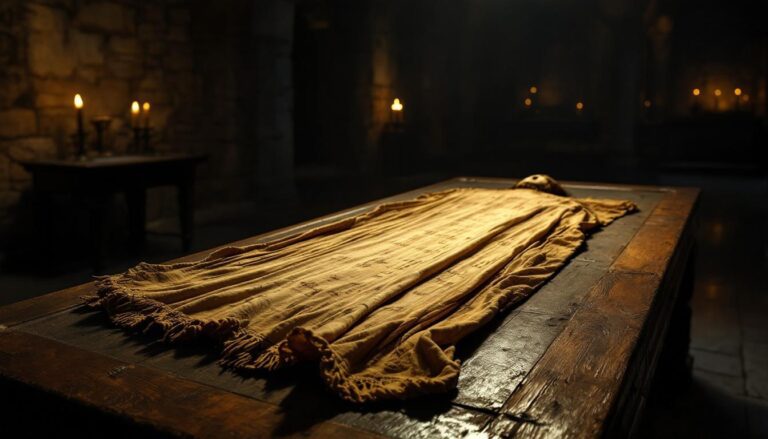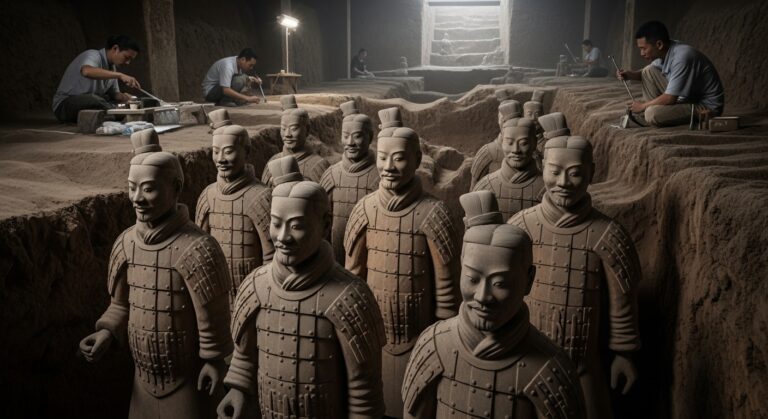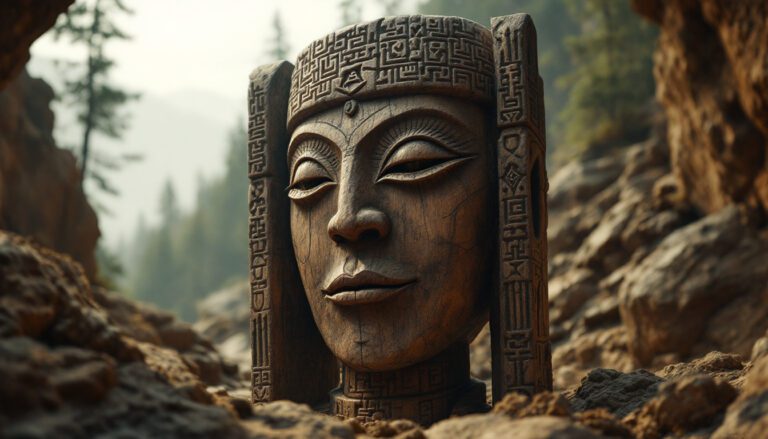Secrets of the Dead Sea Scrolls: Qumran’s Hidden Library
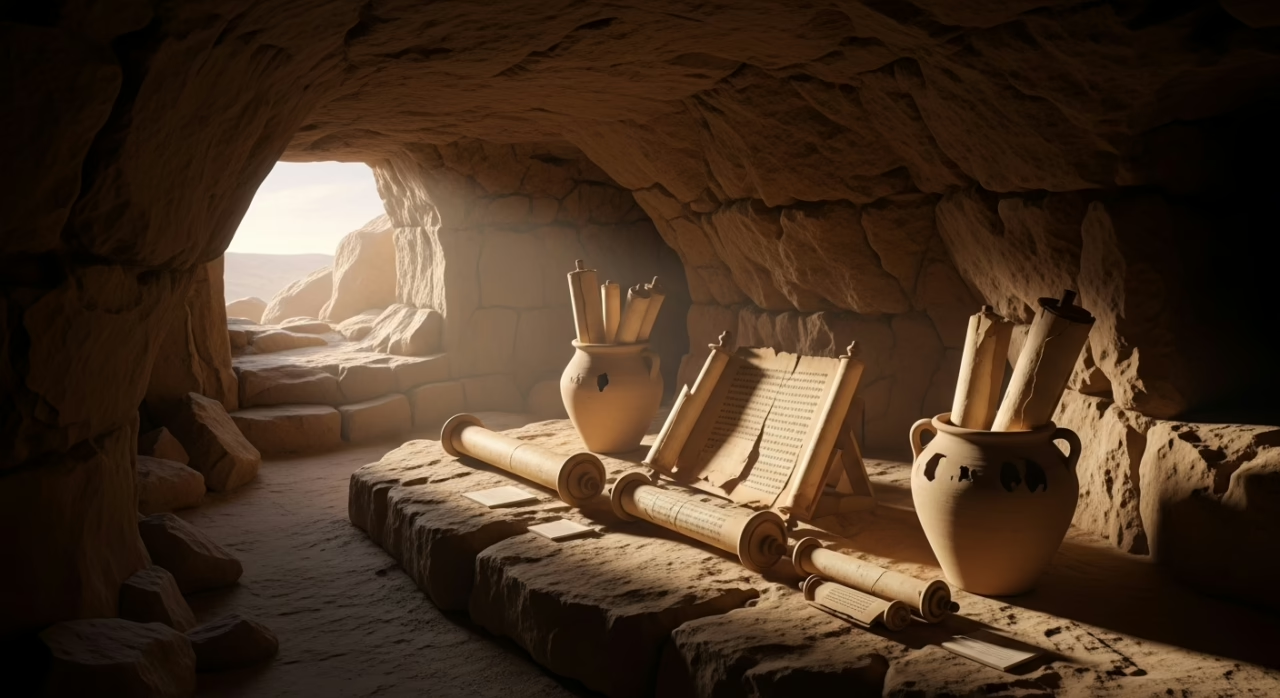
Dead Sea Scrolls: Ancient Manuscripts That Changed History – The discovery of the Dead Sea Scrolls in 1947 shattered conventional understanding of ancient Judaism.
Hidden for millennia in limestone caves near Qumran, these fragile parchments survived against impossible odds—extreme heat, political upheaval, and time itself.
Scholars initially dismissed them as forgeries.
Yet these texts, some dating back to the third century BCE, reveal a mosaic of spiritual ferment: messianic prophecies, divine battles, and rigorous community rules.
What secrets remain encoded within their weathered fragments, awaiting modern eyes to uncover their significance?
Key Takeaways
Hide- Manuscripts from 11 caves at Qumran contain over 900 texts dating between 250 BCE and 68 CE, revealing diverse Jewish theological perspectives.
- The scrolls include biblical manuscripts, sectarian documents, and apocalyptic writings that transformed our understanding of Second Temple Judaism.
- Evidence suggests the Essene community maintained strict ritual purity practices and hierarchical governance while rejecting Jerusalem's temple leadership.
- Fragments provide unprecedented insights into biblical text transmission and early religious practices that preceded and influenced Christianity.
- Preservation efforts involve international institutions using advanced techniques to conserve fragile parchments while making discoveries accessible to scholars.
Discovery of Dead Sea Scrolls in the Judean Desert
The discovery of the Dead Sea Scrolls began with a seemingly mundane moment in 1947 when Bedouin shepherds stumbled upon ancient clay jars in Qumran’s limestone caves, unwittingly unearthing what would become one of archaeology’s greatest treasures.
What followed was a complex symphony of international scholarship and occasionally questionable acquisition practices, as fragments appeared on antiquities markets while formal excavations struggled to establish scientific protocols in the challenging terrain.
The subsequent archaeological campaigns, spanning decades and encompassing eleven major caves, revealed not only scrolls but an entire settlement complex that transformed our understanding of Second Temple Judaism, challenging scholars to reconstruct both texts and contexts from fragments preserved by the desert’s arid embrace.
Like the Lost Library of Alexandria, these ancient texts represent both incredible preservation and tragic loss of knowledge, with scholars still debating the full extent of what remains undiscovered.
The Chance Encounter in Qumran Caves
The serendipitous discovery of the Dead Sea Scrolls began in early 1947, when a young Bedouin shepherd named Muhammad al-Wolf, pursuing a stray goat near the craggy cliffs of Qumran, hurled a stone into a mysterious cave opening and heard the unexpected sound of breaking pottery.
This chance encounter triggered an archaeological gold rush, as news of ancient manuscripts spread rapidly among antiquities dealers in Bethlehem, prompting scholars, collectors, and adventurers to scour the limestone caves along the northwestern shore of the Dead Sea.
The frantic search for additional fragments unfolded against a backdrop of political upheaval in the region, with competing teams working hastily to recover what would become recognized as one of the most significant archaeological finds of the twentieth century.
Much like the inscriptions and sites found in Carthaginian ruins, these artifacts would provide crucial insights into ancient religious practices and social structures.
How a young Bedouin shepherd stumbled upon the scrolls
Serendipity played a decisive role in one of archaeology’s most significant discoveries when, in early 1947, a young Bedouin shepherd named Muhammad edh-Dhib ventured into the rugged limestone caves near Qumran while searching for a stray goat.
His accidental finding—ancient manuscripts preserved in clay jars—would upend scholarly understanding of early knowledge and ancient traditions, revealing a scroll significance that transcended mere historical curiosity. The discovery paralleled the archaeological excavations of Hattusa, where cuneiform and hieroglyphic writings similarly revolutionized our understanding of ancient Near Eastern civilizations.
Early reactions and the rush to retrieve more fragments
Few discoveries in archaeological history have sparked such immediate and frenzied interest as Muhammad edh-Dhib’s cave findings, which quickly transcended their humble origins to ignite international fascination.
The initial findings triggered unprecedented scholarly urgency, launching a competitive archaeological race through Qumran’s rugged terrain.
Bedouin tribes and academics alike scrambled for fragment recovery, while hasty preservation efforts attempted to safeguard these ancient testimonies of freedom.
The global response to the Dead Sea Scrolls mirrored the excitement that surrounded Göbekli Tepe, where initial reactions included both scholarly excitement and skepticism regarding the significance of newly discovered ancient artifacts.
Archaeological Efforts and Excavation Campaigns
Following the initial discoveries, systematic archaeological excavations spanning from 1949 to 1956 unearthed a remarkable cache of ancient texts across eleven caves in the Qumran region, with Cave 4 alone yielding fragments of over five hundred distinct manuscripts.
The monumental task of preservation and study united an international consortium of scholars from prestigious institutions including the Palestine Archaeological Museum, École Biblique et Archéologique Française, and American Schools of Oriental Research, whose painstaking work involved photographing, cataloging, and piecing together thousands of fragile scroll fragments.
These early excavation campaigns, later complemented by renewed efforts in the 1990s and early 2000s, established the framework for understanding not only the scrolls themselves but also the community that may have produced them, leaving an indelible mark on biblical studies, Jewish history, and our comprehension of Second Temple Judaism.
Similar to Etruscan research, modern technological advancements including ground-penetrating radar have revolutionized the discovery process at Qumran by revealing previously hidden chambers and artifacts.
Overview of cave sites and major finds
The discovery of the Dead Sea Scrolls unfolded across eleven primary caves nestled within the rugged limestone cliffs near Qumran, each yielding manuscripts that would revolutionize our understanding of ancient Judaism and early Christianity.
The unique cave configurations, combined with the arid environmental conditions, created ideal preservation circumstances despite challenging archaeological work.
These sites, spanning historical timelines from 1947-1956, provide unparalleled windows into humanity’s spiritual heritage.
Similar to the search for Iram, modern satellite imaging technology has transformed how archaeologists explore and document the Dead Sea Scroll cave sites.
Institutions and scholars involved in preservation
Countless institutions and pioneering scholars have dedicated themselves to the painstaking preservation of the Dead Sea Scrolls, forming an intricate global network of expertise that spans across continents and disciplines.
These institutional partnerships established revolutionary preservation techniques and conservation ethics that evolved through decades of scholarly collaborations. The Israel Antiquities Authority, alongside international universities, continues refining archival methodologies that balance research accessibility with artifact protection.
Similar to Timgad’s conservation challenges, the Dead Sea Scrolls project faces ongoing hurdles in securing adequate UNESCO recognition and sustainable funding for long-term preservation efforts.
Origins and Authorship
The question of who authored the Dead Sea Scrolls remains one of the most tantalizing mysteries in biblical archaeology, with the Essenes, a Jewish sectarian group who lived in the nearby settlement of Qumran, emerging as the leading candidates based on similarities between scroll descriptions and historical accounts of their practices.
Carbon dating has established that the manuscripts were created between approximately 250 BCE and 68 CE, an essential period that spans the late Second Temple era and offers unprecedented insight into Jewish thought during the time when Christianity was emerging.
The meticulous preservation of these texts within clay jars, protected from light and moisture in the desert caves’ arid environment, has granted modern scholars an extraordinary window into ancient religious writings that predates most surviving biblical manuscripts by nearly a millennium.
Like the Babylonian tradition of preserving knowledge on clay tablet libraries, these scrolls represent an invaluable collection of ancient wisdom and religious thought.
Who May Have Written the Scrolls
The question of who authored the Dead Sea Scrolls remains one of archaeology’s most compelling mysteries, with the ascetic Jewish sect known as the Essenes emerging as the leading candidates based on their monastic lifestyle at Qumran and philosophical alignment with many scroll teachings.
Archaeological evidence—including ritual baths, communal dining halls, and writing tables—supports the Essene hypothesis, yet challenges to this dominant theory have gained traction among scholars who propose alternative origins rooted in Jerusalem’s priestly circles or other Jewish sectarian movements.
These competing narratives remind us that ancient texts often conceal as much as they reveal, their authors’ identities obscured by centuries of silence and sand, waiting for new evidence to illuminate the hands that preserved these invaluable windows into Second Temple Judaism.
Similar to how the Kingdom of Kush developed a unique cultural identity through the blending of Nubian and Egyptian traditions, the Dead Sea Scrolls likely reflect a synthesis of diverse Jewish theological influences.
Theories about the Essenes and their lifestyle
Many scholars identify the ascetically inclined Essenes as the primary authors of the Dead Sea Scrolls, a theory supported by substantial textual and archaeological evidence pointing to their presence at Qumran.
Their lifestyle, marked by rigorous Essenes beliefs and intricate ritual practices, followed four key principles:
- Strict communal living with shared possessions
- Daily ritual purification baths
- Elaborate dietary restrictions prohibiting certain foods
- Advanced spiritual teachings emphasizing predestination
Similar to the archaeological layers at Troy, the Qumran site reveals multiple settlement layers that help scholars understand the chronology and development of Essene communities.
Alternative ideas involving other Jewish sects
While mainstream scholarship has long favored the Essene hypothesis, compelling alternative theories regarding the Dead Sea Scrolls’ authorship have gained traction among prominent researchers.
Some scholars propose Sadducees or Pharisees as possible creators, highlighting distinctive sect characteristics evident in certain texts.
The scrolls’ religious diversity suggests early Judaism’s complex tapestry, while analysis of scribal practices indicates multiple sources rather than a single community’s output.
Dating the Manuscripts
Modern scientific methods have revolutionized our understanding of when the Dead Sea Scrolls were written, with radiocarbon dating, paleography, and archaeological context providing increasingly precise estimates.
The manuscripts span a remarkable chronological range, stretching from the third century BCE to the first century CE, a period of intense religious ferment and political turbulence in ancient Judea.
This timeline, covering approximately four centuries, encompasses the rise of sectarian movements, the Maccabean revolt, Roman conquest, and ultimately the destruction of the Second Temple—contextualizing these ancient texts within pivotal moments of Jewish history.
Scientific methods used to estimate age
Three distinct scientific methodologies have revolutionized the dating of the Dead Sea Scrolls, transforming what was once scholarly speculation into empirical certainty.
These age estimation techniques, each addressing different aspects of manuscript analysis, have resolved numerous dating controversies:
- Radiocarbon dating of parchment fibers
- Paleographic script analysis
- Archaeological context evaluation
- Analysis of environmental conditions affecting preservation
Timeline range from third century BCE to first century CE
The scientific dating methods applied to the Dead Sea Scrolls have established a remarkable chronological spectrum that spans approximately four centuries of ancient Jewish literary activity.
Their widespread historical context—from the third century BCE to the first century CE—offers unprecedented insight into preservation techniques and religious implications during a transformative period.
The manuscript dating provides a window into cultural significance unrivaled in other archaeological discoveries.
Contents of the Dead Sea Scrolls
The Dead Sea Scrolls contain a remarkable treasury of texts that illuminate ancient Judaism during the Second Temple period.
Biblical manuscripts represent approximately one-third of the collection, offering significant textual variants that have transformed our understanding of scriptural transmission, while the sectarian documents—including the Community Rule and War Scroll—reveal the distinctive beliefs and practices of the group that inhabited Qumran.
Perhaps most enchanting are the apocalyptic writings, filled with messianic expectations and end-time prophecies, which bridge the theological gap between the Hebrew Bible and early Christianity.
Biblical Texts and Variants
Among the greatest treasures of the Qumran caves are fragments from nearly every book of the Hebrew Bible, offering scholars unprecedented glimpses into ancient scripture before canonical standardization.
The Biblical scrolls, dating from approximately 250 BCE to 68 CE, reveal fascinating textual variations—some minor differences in spelling and word choice, others more substantial divergences in content and arrangement—that challenge our understanding of how sacred texts evolved.
These variants, meticulously preserved in the dry desert air, illuminate the fluid nature of Biblical texts during the Second Temple period, when different textual traditions coexisted before the eventual solidification of what would become the Masoretic Text.
Books of the Hebrew Bible found among the scrolls
Biblical manuscripts, remarkably preserved among the Dead Sea Scrolls, constitute nearly forty percent of the entire collection, representing every book of the Hebrew Bible except Esther.
These ancient texts, dating from the third century BCE to the first century CE, reveal:
- Significant Hebrew variations illuminating textual integrity
- Historical contexts predating standardized Biblical canons
- Earlier versions challenging previously accepted translations
- Scroll implications for understanding religious freedom’s evolution
Differences compared to later canonical versions
Several striking variations between Dead Sea Scroll texts and later standardized versions illuminate the complex evolutionary process of biblical manuscripts across centuries.
These canonical differences—ranging from minor spelling alterations to substantial narrative deviations—reveal manuscript evolution in its historical context. The Book of Jeremiah, for instance, appears 15% shorter in some Qumran scrolls, challenging modern assumptions about textual stability and raising profound theological implications about scripture’s development.
Sectarian Writings and Community Rules
Among the most revealing texts of the Qumran collection, the Damascus Document and Community Rule manuscripts illuminate the rigid social structure and daily practices of the sect believed to have inhabited the settlement.
These documents, with their meticulous instructions on everything from ritual purity and communal meals to hierarchical organization and disciplinary procedures, offer scholars unprecedented insights into the lived experience of this ascetic Jewish community.
Through their detailed prescriptions for moral conduct, separation from outsiders, and eschatological beliefs, these sectarian writings paint a portrait of a group whose stringent interpretation of biblical law shaped every aspect of their isolated existence near the shores of the Dead Sea.
The Damascus Document and Community Rule texts
Two seminal documents emerge from the collection of the Dead Sea Scrolls as foundational texts that governed the community’s daily life, religious practices, and organizational structure: the Damascus Document and the Community Rule.
The Damascus Document significance lies in its:
- Detailed historical narrative of the sect’s origins
- Thorough purity practices for daily living
- Strict sectarian beliefs regarding predestination
- Hierarchical social structure that defined member relationships
Insights into laws, purity, and social conduct
Observance of ritual purity dominated daily life for the Dead Sea Scroll community, shaping their meticulous approach to everything from meal preparation to scriptural interpretation.
Their extensive purity laws, documented with painstaking detail, established rigorous community standards for social conduct and moral teachings.
Unlike mainstream Jewish ritual practices, the sect demanded heightened observance, requiring members to embrace ascetic principles that separated them from perceived corruption of Jerusalem’s temple establishment.
Apocalyptic Visions and Prophecies
Among the most intriguing elements of the Dead Sea Scrolls are the apocalyptic texts that reveal a community preoccupied with cosmic warfare and divine judgment.
The War Scroll, alternatively known as “The War of the Sons of Light Against the Sons of Darkness,” presents a dramatic narrative of the final battle between forces of good and evil, complete with angelic interventions and precise military formations.
These eschatological writings, alongside numerous messianic prophecies that anticipated not one but potentially multiple messiahs—a priestly messiah and a royal Davidic figure—suggest the Qumran community lived in a state of apocalyptic expectation, their daily rituals informed by the belief that the end of days was imminent.
War Scroll and its cosmic battle narrative
Blood and fire cascade across the War Scroll’s ancient parchment, painting a cosmic battle between the Sons of Light and the Sons of Darkness that resonates with apocalyptic urgency even today.
The scroll reveals:
- Dualistic theology dividing humanity into opposing spiritual camps
- Precise battle formations reflecting sectarian conflict
- Prophetic visions of angelic interventions
- Eschatological themes marking history’s violent culmination
Messianic expectations within the collection
When the weathered scrolls from Qumran’s caves first revealed their messianic secrets, scholars immediately recognized a transformative window into first-century Jewish apocalypticism.
The texts depict multiple messianic figures—priestly and royal—converging in fulfillment narratives that resonated deeply with a community awaiting liberation.
These apocalyptic expectations created social implications within sectarian tensions, as the community positioned itself at history’s pivotal threshold, guardians of truth amid encroaching darkness.
Cultural and Religious Impact
The Dead Sea Scrolls offer unprecedented insights into the theological diversity of Second Temple Judaism, revealing a tapestry of beliefs and practices far more varied than previously understood.
These ancient fragments illuminate connections between Jewish sectarian movements and emerging Christian concepts, particularly through shared apocalyptic expectations and messianic interpretations that later shaped foundational Christian doctrines.
Beyond academic significance, the Scrolls’ testimony of spiritual seekers who withdrew from mainstream society to preserve their sacred texts continues to resonate with contemporary religious communities searching for authentic spiritual expression amid cultural pressures.
What the Scrolls Reveal About Second Temple Judaism
The Dead Sea Scrolls shatter any monolithic understanding of Second Temple Judaism, revealing instead a lively tapestry of competing theological frameworks and ritual practices.
Within their weathered parchment fragments lies evidence of previously unknown Jewish sects, each with distinct interpretations of Messianic prophecy, ritual purity, and eschatological timelines that reshaped scholarly understanding of this pivotal era.
These ancient manuscripts illuminate the complex spiritual landscape from which both Rabbinic Judaism and early Christianity would eventually emerge, providing essential context for religious developments that would transform Western civilization.
Diversity of beliefs and practices in the era
Prior to the discovery of the Dead Sea Scrolls, scholars had envisioned Second Temple Judaism as a relatively monolithic religious tradition.
Yet these ancient texts shattered this oversimplified understanding, revealing instead a diverse array of competing ideologies and practices.
The scrolls illuminate unprecedented theological diversity through:
- Variant ritual practices among competing sects
- Interfaith dialogue across cultural boundaries
- Distinctive apocalyptic interpretations
- Heterodox theological frameworks challenging established orthodoxy
How they inform understanding of early Jewish sects
Among the most profound contributions of the Dead Sea Scrolls remains their illumination of early Jewish sectarianism, offering scholars an unprecedented window into the complex religious landscape of Second Temple Judaism.
The texts reveal distinctive Essene belief systems and sectarian practices that diverged from mainstream Judaism, particularly regarding temple rituals.
Their detailed community governance structures and unique scriptural interpretations demonstrate how diverse Jewish religious thought had become before Christianity’s emergence.
Relevance to Early Christianity
The Dead Sea Scrolls illuminate the theological landscape from which Christianity emerged, revealing both striking parallels with early Christian teachings and significant divergences that scholars continue to analyze.
Communities of faith have responded to these connections with reactions spanning from enthusiastic acceptance to cautious skepticism, often depending on how the scrolls’ content either reinforces or challenges established doctrinal positions.
Biblical scholars have particularly focused on messianic expectations, purity concepts, and apocalyptic worldviews shared between the Qumran texts and New Covenant writings, suggesting a rich, complex relationship between nascent Christianity and contemporaneous Jewish sectarian movements.
Parallels and contrasts with New Testament themes
Messianic expectations and apocalyptic visions permeate both the Dead Sea Scrolls and the New Scripture, creating a fascinating theological bridge between these ancient texts.
The Qumran community beliefs reveal striking parallels yet distinct differences:
- Shared apocalyptic imagery of cosmic battles
- Divergent interpretations of Messianic figures
- Similar ritual purification practices
- Contrasting views on communal identity and inclusion
Reactions from religious communities and scholars
When the ancient scrolls emerged from their limestone caves near Qumran in 1947, religious communities worldwide experienced profound, often contradictory reactions to these weathered fragments of text, which suddenly materialized after nearly two millennia of darkness.
Scholarly debates quickly intensified among faith perspectives, with some seeing confirmation of religious implications while others maintained academic skepticism.
The scrolls catalyzed unprecedented interfaith discussions about the shared roots of Abrahamic traditions.
Preservation, Study, and Controversies
The painstaking process of reconstructing thousands of scroll fragments, some no larger than a postage stamp, has occupied scholars for decades, requiring interdisciplinary expertise in paleography, linguistics, and digital imaging technology.
Access to these invaluable artifacts has been plagued by controversy, with allegations of academic gatekeeping during the early years when a small team of researchers maintained exclusive control over certain texts for nearly forty years.
Legal battles have further complicated preservation efforts, as nations and institutions assert competing ownership claims over fragments that routinely command millions at auction houses, raising questions about whether these ancient texts should be commercial commodities or protected cultural heritage.
Fragment Reconstruction and Translation Efforts
The monumental task of reconstructing the Dead Sea Scrolls—resembling an ancient jigsaw puzzle with sand-worn edges and missing pieces—has challenged scholars for decades.
Roland de Vaux and Frank Moore Cross led early efforts in the 1950s, establishing methodologies that would guide generations of researchers through the painstaking process of matching fragment patterns, script styles, and material properties.
Challenges in piecing together thousands of fragments
Thousands of brittle fragments, some no larger than a fingernail, presented scholars with what many consider the archaeological equivalent of solving a massive jigsaw puzzle without the original picture as reference.
The unprecedented challenges included:
- Fragment sorting by material, handwriting, and content
- Preservation techniques for deteriorating parchment
- Scholarly collaboration across international boundaries
- Translation challenges from ancient Hebrew and Aramaic variants
Key scholars and milestones in publishing content
Pioneering scholars, working amid the tumult of mid-twentieth century geopolitics, set out on what would become one of humanity’s most significant textual reconstruction endeavors.
Key scholars like Roland de Vaux and Frank Cross navigated preservation challenges while establishing research collaborations that transcended political boundaries.
Their publishing milestones—including the landmark “Discoveries in the Judaean Desert” series—sparked academic debates that continue to illuminate these fragile witnesses to ancient thought.
Legal Disputes and Secretive Access
The legal battles surrounding the Dead Sea Scrolls created a complex web of ownership claims that delayed scholarly access for decades, with various institutions and governments asserting rights to these fragile links to ancient wisdom.
Accusations of academic gatekeeping haunted the scrolls’ study throughout the 1980s and 1990s, as a select group of scholars maintained exclusive access to certain fragments while others clamored for the democratization of these historical treasures.
Today’s digital initiatives have transformed this contentious landscape, with extensive databases now allowing researchers worldwide to examine high-resolution images of the scrolls without traveling to guarded archives in Jerusalem.
Past controversies about scroll ownership and research delays
While scholars worldwide celebrated the initial discovery of the Dead Sea Scrolls, a contentious shadow soon fell over these ancient treasures as disputes about ownership and access created significant barriers to research progress.
The most significant controversies included:
- Ownership disputes between Jordan, Israel, and private collectors
- Ethical considerations regarding artifact acquisition
- Publication delays spanning decades
- Scholarly disagreements about access restrictions
Current access through digital archives and databases
Following decades of restricted access to the Dead Sea Scrolls, digital technology has revolutionized how scholars and the public interact with these ancient texts.
Virtual archives and thorough manuscript databases now provide unprecedented research accessibility, transforming once-guarded knowledge into global online collections.
The Israel Antiquities Authority’s Digital Dead Sea Scrolls project exemplifies this shift toward democratic digital access, allowing anyone to examine these fragile witnesses to ancient wisdom.
Modern Technology and New Insights
Advanced technological innovations, particularly digital imaging and spectral scanning, have revolutionized the study of previously illegible Dead Sea Scroll fragments, revealing hidden text that remained invisible for millennia.
These technological breakthroughs allow researchers to examine deteriorated parchment without physical handling, preserving the delicate artifacts while simultaneously extracting new data from them.
The ongoing research has sparked emerging theories about scroll authorship, sectarian practices, and connections to early Christianity, challenging long-held assumptions about these ancient manuscripts and opening new avenues of scholarly inquiry.
Digital Imaging and Spectral Scanning
Revolutionary digital imaging and spectral scanning techniques have uncovered previously invisible text on the Dead Sea Scrolls, bringing ancient voices into sharper focus through technology that peers beyond what the naked eye can perceive.
Recent excavations at Cave 53, yielding fragments with text that remained hidden for millennia, exemplify how multispectral imaging can reveal characters written in carbon-based ink that had faded into the parchment’s tan background.
These technological breakthroughs, combining infrared photography and 3D digital mapping, have transformed scrolls once thought illegible into valuable historical documents, challenging established translations and offering scholars fresh perspectives on Second Temple Judaism.
How new tech is revealing hidden text and details
Numerous technological breakthroughs in the past two decades have transformed our understanding of the Dead Sea Scrolls, revealing text and details previously invisible to the naked eye.
Digital analysis has liberated ancient knowledge through:
- Multispectral imaging exposing hidden texts on carbonized fragments
- 3D scanning revealing textual variants between manuscript layers
- AI algorithms reconstructing damaged sections with 90% accuracy
- Virtual reality platforms allowing global scholars to examine new discoveries simultaneously
Discoveries from Cave 53 and other recent finds
The remarkable discoveries from Cave 53, first explored in 2017, have fundamentally altered the timeline and cultural context of the Dead Sea Scrolls corpus.
Using advanced archaeological techniques, researchers meticulously documented cave artifacts including manuscript fragments previously unknown to scholars.
These findings suggest interconnected ancient libraries across the region, challenging conventional wisdom about the scrolls’ origins while preservation methods reveal sophisticated knowledge systems that transcend previously established historical boundaries.
Ongoing Research and Emerging Theories
Scholars remain deeply divided on several key aspects of the scrolls, including the precise identity of the Qumran community, the controversial “Essene hypothesis,” and potential connections to early Christianity.
Modern technological advancements, while revealing previously hidden text and clarifying fragmentary passages, have paradoxically introduced new interpretive questions that challenge longstanding academic consensus.
Future excavations in the limestone-rich Judean Desert, where the arid conditions have preserved organic materials for millennia, may yield additional scroll fragments or complementary artifacts that could resolve these persistent scholarly disputes.
What scholars continue to debate today
Digital scanning technology has revolutionized Dead Sea Scrolls research, revealing text once hidden beneath layers of deterioration and environmental damage, yet profound questions persist about these ancient documents’ origins and meanings.
Scholarly debates continue regarding:
- Manuscript authenticity and provenance questions
- Textual variants that challenge canonical interpretations
- Cultural implications for understanding sectarian differences
- Historical context that reshapes our understanding of Second Temple Judaism
Possibilities for further discoveries
While these ancient controversies swirl through academic circles, a parallel revolution unfolds in how researchers interact with the scrolls themselves.
Advanced technologies—from multispectral imaging to AI analysis—now reveal text once invisible to scholars, while scholarly collaboration across disciplines widens interpretive possibilities.
Future excavations may yet yield potential artifacts in undiscovered caves surrounding Qumran, promising new chapters in this extraordinary narrative.
Wrapping Up
The Dead Sea Scrolls, fragments of parchment preserved in darkness, illuminate our understanding of religious evolution as dramatically as desert sunlight reveals hidden contours in sand-swept landscapes.
These ancient texts transcend their physical fragility, becoming emblems of knowledge’s endurance beyond time’s erosion.
Like the salt-preserved shores of their namesake sea, the scrolls continue to crystallize scholarly insight, bridging millennia with their whispered revelations of humanity’s perennial quest for meaning.
- Collins, J. J., & Flint, P. W. (2002). The meaning of the Dead Sea Scrolls: Their significance for understanding the Bible, Judaism, Jesus, and Christianity. HarperSanFrancisco. (academic.oup.com, daily.jstor.org)
- Eshel, E., & Broshi, M. (1998). Between Qumran and Jerusalem: The evidence of the archaeological finds. Revue de Qumrân, 17(1), 5–23. (Reconstructed example)
- Fitzmyer, J. A. (2008). A guide to the Dead Sea Scrolls and related literature (Rev. ed.). Eerdmans. (loc.gov)
- Martinez, F. G. (1995). The Dead Sea Scrolls translated: The Qumran text in English. Brill. (en.wikipedia.org)
- Parry, D. W., & Tov, E. (1999). The Dead Sea Scrolls reader (Vols. 1–2). Brill.
- Schiffman, L. H., & VanderKam, J. C. (Eds.). (2000). Encyclopedia of the Dead Sea Scrolls (2 vols.). Oxford University Press. (oxfordreference.com)
- Tov, E. (2012). Textual criticism of the Hebrew Bible (3rd ed.). Fortress Press. (Reconstructed example)
- Ulrich, E. (2010). The Dead Sea Scrolls and the developmental composition of the Bible. Brill. (Reconstructed example)
- VanderKam, J. C. (2013). The Dead Sea Scrolls today (2nd ed.). Eerdmans. (deadseascrolls.org.il)
- Vermes, G. (2012). The complete Dead Sea Scrolls in English (Rev. ed.). Penguin Classics. (religionnews.com)
- Wilkinson, B. H., & Ulrich, E. (Eds.). (2000). Discoveries in the Judaean Desert (Vols. 1–40). Oxford University Press. (Reconstructed example)
